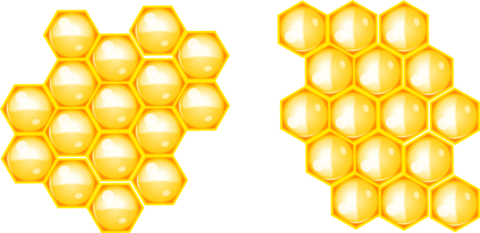Honeycomb Perfection
Honey bees have long been regarded as symbols of thrift and industry. They work very hard for what they have and any decision that requires the consumption of hard earned resources is not taken lightly.
Honeycomb is a perfect example of minimizing resources and maximizing efficiency. Making wax is an expensive proposition for bees. To make 1 pound of wax, bees must consume roughly 8 pounds of honey! So when we look at the cost to the hive, they need a structure that maximizes storage space and minimizes material required. Well, it’s not a coincidence that bees settled on a hexagon as the shape for their cells.
In order for bees to be able to build multiple cells in the honeycomb at one time they had to choose a single, non-random shape. There are three geometric shapes that can fit together on a flat surface without leaving gaps (which is wasted wax) – an equilateral triangle, a square and a hexagon. So which to choose? Well the most compact of the three – the hexagon! Though it was theorized for thousands of years that the hexagon was the most compact structure, it wasn’t until 1999 that Thomas Hales finally proved it mathematically!! The bees have known this for thousands of years, and we finally caught up!
Today we see this structure used all around us in what is termed bio-mimicry. In applications where we need to minimize material and weight, but maximize strength, there is a good chance you will see a honeycomb structure.
So here is a tricky question – in what orientation do the bees build there hexagons? Bees build comb from the top down. Picturing that, do they build the hexagons horizontally (picture on the left) or vertically (picture on the right)?

It turns out that the answer is both! If bees are given the choice, meaning there is no foundation or previously built cells in the comb they may choose either direction. Even combs within the same hive may be oriented differently. However, once construction on a comb has begun the orientation will remain the same for that comb. Statistically speaking, it appears they are as likely to choose one orientation as the other except when building drone comb (cells for male bees which are larger then workers). In that case they are more likely to choose the vertical orientation (picture on the right). Amazing bees!
If you’re interested in more detail you can read this study – http://www.jas.org.pl/pdf/99?filename=jas_50_2_2006_4.pdf.

 Curated in Louisville, KY
Curated in Louisville, KY